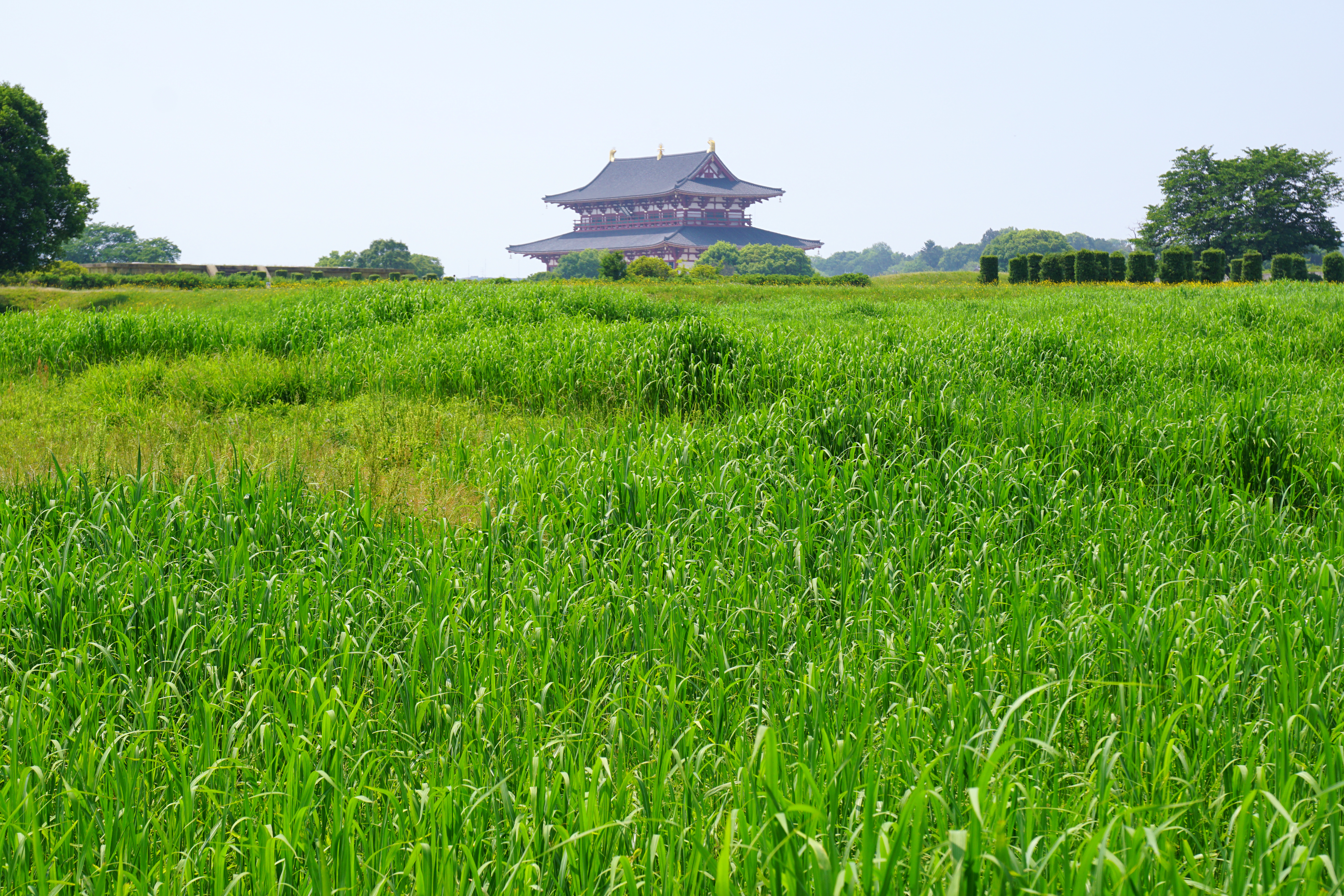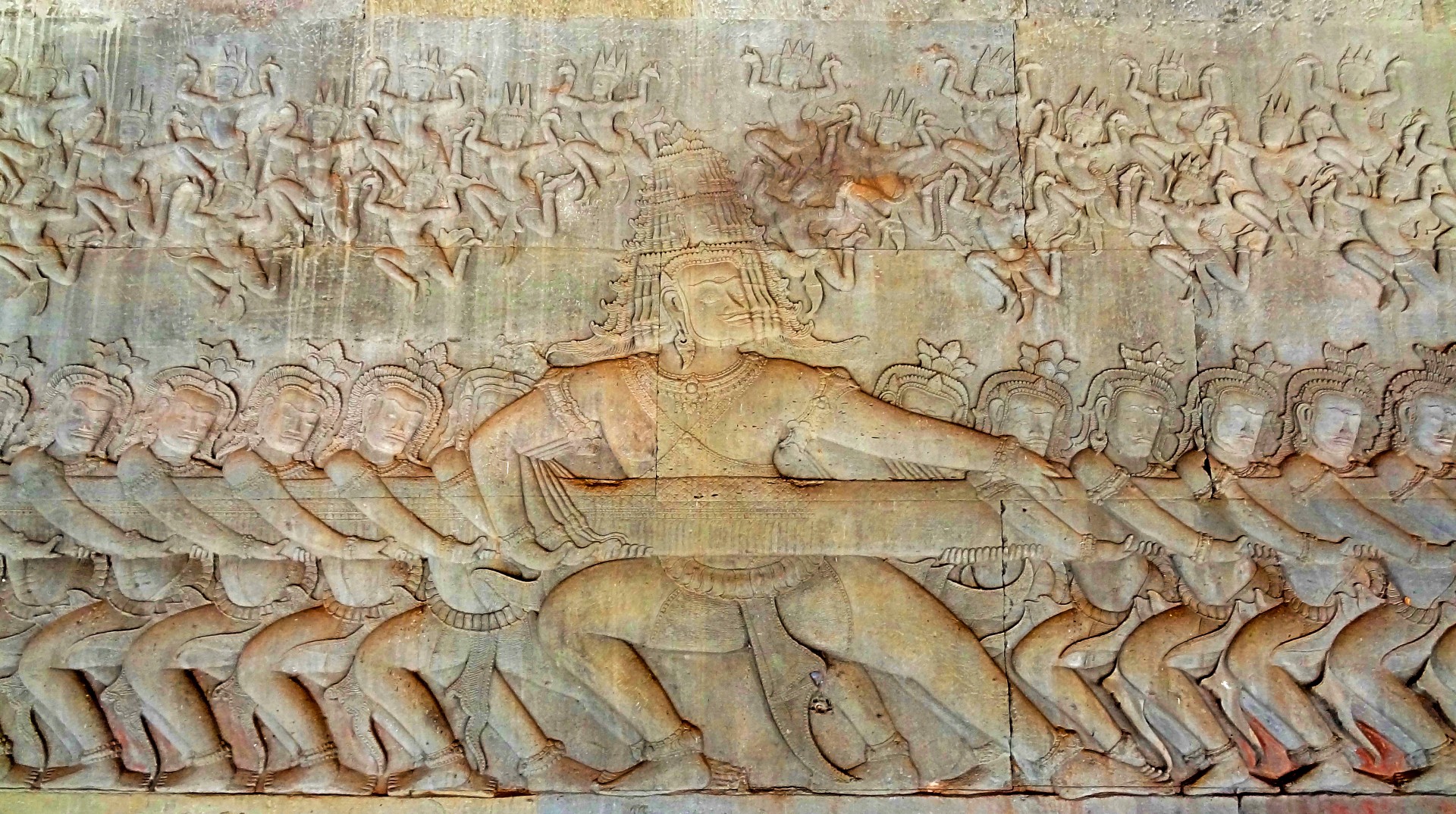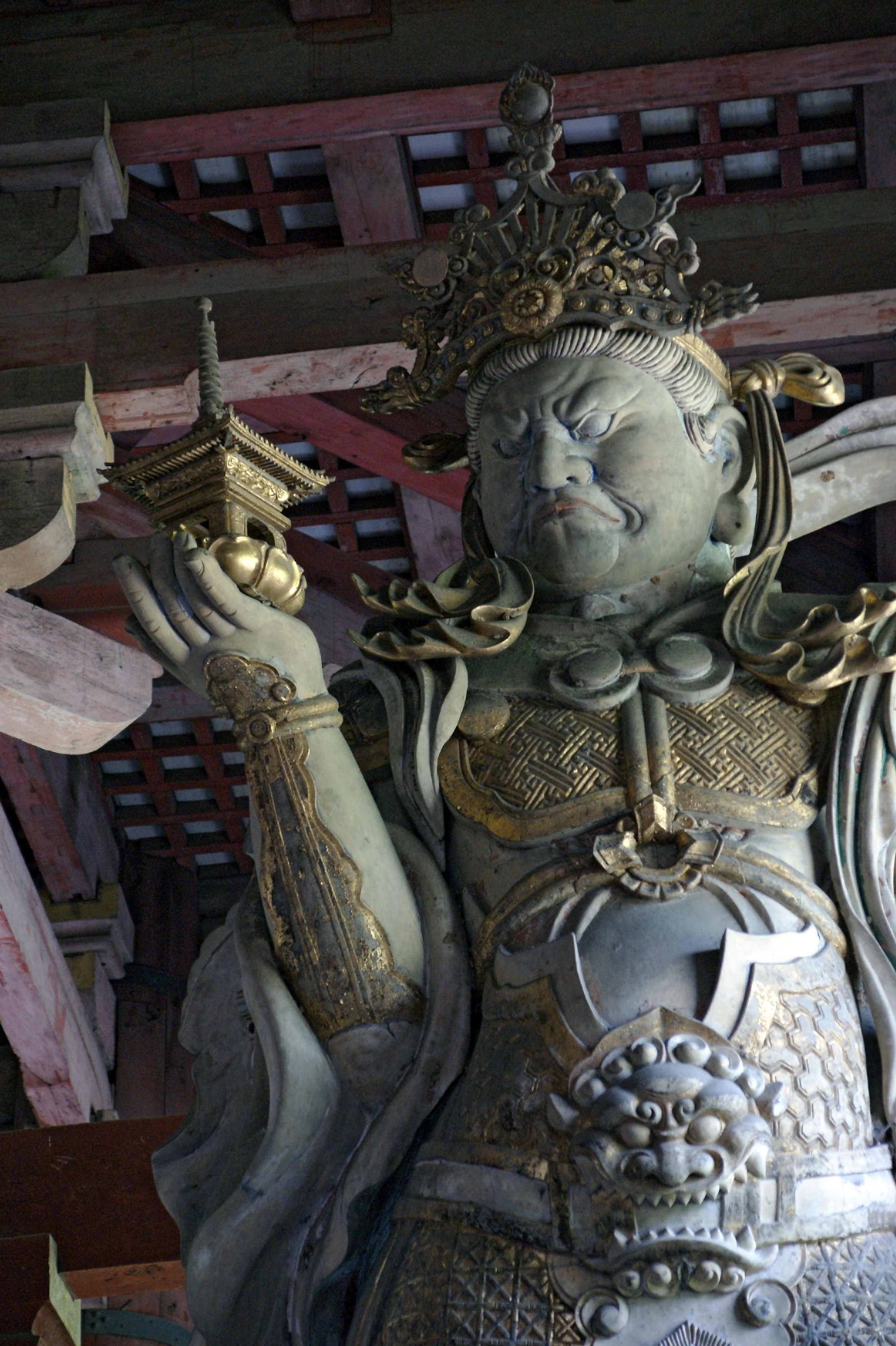|
Sento-kun
is a yuru-chara mascot created by Nara, Nara, Nara City Office to commemorate the 1300th anniversary of Nara Heijō-kyō, the ancient capital of Japan, in 2010. The city of Nara has a long tradition of adopting guardian deities such as Nio (Buddhism), Nio (a pair of temple guardians), Asura, Jūni Shinshō (Twelve Heavenly Generals) and Four Heavenly Kings, Shitenno (Four Guardian Kings). The new mascot was chosen by the city office to inherit their mission, and as a "personification of the energy" of the ancient capital dotted with temples, gardens and shrines. Sento-kun is meant to resemble an amiable young boy who has the antlers of a deer, an animal which has long been regarded as a heavenly protector of the city. Character design The character was designed by Satoshi Yabuuchi, a sculptor and professor at Tokyo University of the Arts, who was one of twelve guest designers invited by the Association for Commemorative Events of the 1300th Anniversary of the Nara-Heijyokyo Ca ... [...More Info...] [...Related Items...] OR: [Wikipedia] [Google] [Baidu] |
Yuru-chara
is a Japanese term for a category of mascot characters; usually created to promote a place or region, event, organisation or business. They are characterized by their '' kawaii'' (cute) and unsophisticated designs, often incorporating motifs that represent local culture, history or produce. They may be created by local government or other organizations to stimulate tourism and economic development, or created by a company to build on their corporate identity. They may appear as costumed characters (or '' kigurumi'') at promotional events and festivals. ''Yuru-kyara'' has become a popular and lucrative business, with character-driven sales reaching nearly $16 billion in Japan in 2012. Popular ''yuru-kyara'' include Kumamon, Funassyi, and Chiitan, who have gained international recognition and have reached celebrity status in Japan. Etymology The name ''yuru-chara'' is a contraction of . The adjective generally means "loose", but in this application it has a number of con ... [...More Info...] [...Related Items...] OR: [Wikipedia] [Google] [Baidu] |
Mascot
A mascot is any human, animal, or object thought to bring luck, or anything used to represent a group with a common public identity, such as a school, sports team, university society, society, military unit, or brand, brand name. Mascots are also used as fictional, representative spokespeople for consumer products. In sports, mascots are also used for merchandising. Team mascots are often related to their respective team athletic nickname, nicknames. This is especially true when the team's nickname is something that is a living animal and/or can be anthropomorphism, made to have humanlike characteristics. For more abstract nicknames, the team may opt to have an unrelated character serve as the mascot. For example, the sport, athletic teams of the University of Alabama are nicknamed the Alabama Crimson Tide, Crimson Tide, while their mascot is an elephant named Big Al (mascot), Big Al. Team mascots may take the form of a logo, person, live animal, inanimate object, or a costumed c ... [...More Info...] [...Related Items...] OR: [Wikipedia] [Google] [Baidu] |
Nara, Nara
is the capital city of Nara Prefecture, Japan. , Nara has an estimated population of 367,353 according to World Population Review, making it the largest city in Nara Prefecture and sixth-largest in the Kansai region of Honshu. Nara is a core city located in the northern part of Nara Prefecture bordering the Kyoto Prefecture. Nara was the capital of Japan during the Nara period from 710 to 784 as the seat of the Emperor before the capital was moved to Nagaoka-kyō, except for the years 740 to 745, when the capital was placed in Kuni-kyō, Naniwa-kyō and Shigaraki Palace. Nara is home to eight major historic temples, shrines, and heritage sites, specifically Tōdai-ji, Saidai-ji, Kōfuku-ji, Kasuga Shrine, Gangō-ji, Yakushi-ji, Tōshōdai-ji, and the Heijō Palace, together with Kasugayama Primeval Forest, collectively form the Historic Monuments of Ancient Nara, a UNESCO World Heritage Site. Etymology By the Heian period, a variety of different characters had ... [...More Info...] [...Related Items...] OR: [Wikipedia] [Google] [Baidu] |
Heijō-kyō
was the Capital of Japan during most of the Nara period, from 710 to 740 and again from 745 to 784. The imperial palace is a listed UNESCO World Heritage together with other places in the city of Nara (cf. Historic Monuments of Ancient Nara). Empress Genmei ordered the Imperial capital moved from Fujiwara-kyō to Heijō-kyō in 708, and the move to Heijō-kyō was complete in 710. Heijō-kyō was modeled after Chang'an, the capital of Tang-dynasty China, although Heijō-kyō lacked walls. In the city, merchants and traders from China, Korea and India introduced various foreign cultures to Heijō-kyō through the Silk Road. As a result, Heijō-kyō flourished as Japan's first international and political capital, with a peak population of between 50,000 and 100,000. The overall form of the city was an irregular rectangle, and the area of the city was more than 25 km2. Architecture In the area of Heijō-kyō, there are ancient Buddhist temples, and some temples are ... [...More Info...] [...Related Items...] OR: [Wikipedia] [Google] [Baidu] |
Japan
Japan is an island country in East Asia. Located in the Pacific Ocean off the northeast coast of the Asia, Asian mainland, it is bordered on the west by the Sea of Japan and extends from the Sea of Okhotsk in the north to the East China Sea in the south. The Japanese archipelago consists of four major islands—Hokkaido, Honshu, Shikoku, and Kyushu—and List of islands of Japan, thousands of smaller islands, covering . Japan has a population of over 123 million as of 2025, making it the List of countries and dependencies by population, eleventh-most populous country. The capital of Japan and List of cities in Japan, its largest city is Tokyo; the Greater Tokyo Area is the List of largest cities, largest metropolitan area in the world, with more than 37 million inhabitants as of 2024. Japan is divided into 47 Prefectures of Japan, administrative prefectures and List of regions of Japan, eight traditional regions. About three-quarters of Geography of Japan, the countr ... [...More Info...] [...Related Items...] OR: [Wikipedia] [Google] [Baidu] |
Nio (Buddhism)
are two wrathful and muscular guardians of the Gautama Buddha, Buddha standing today at the entrance of many Buddhist temples in East Asian Buddhism in the form of frightening wrestler-like statues. They are dharmapala manifestations of the bodhisattva Vajrapāṇi, the oldest and most powerful of the Mahayana Buddhist pantheon (gods), pantheon. According to scriptures like the Pāli Canon as well as the ''Ambaṭṭha Sutta'', they travelled with Gautama Buddha to protect him. Within the ahimsa, generally pacifist tradition of Buddhism, stories of dharmapalas justified the use of physical force to protect cherished values and beliefs against evil. They are also seen as a manifestation of Mahasthamaprapta, the bodhisattva of power that flanks Amitābha in Pure Land Buddhism and as Vajrasattva in Tibetan Buddhism. Manifestations Symbolic meaning They are usually portrayed as a pair of figures that stand guarding temple entrance gates usually called ''Shanmen, Shānmén'' (山 ... [...More Info...] [...Related Items...] OR: [Wikipedia] [Google] [Baidu] |
Asura
Asuras () are a class of beings in Indian religions, and later Persian and Turkic mythology. They are described as power-seeking beings related to the more benevolent Devas (also known as Suras) in Hinduism. In its Buddhist context, the word is translated as "titan" or " antigod". According to Hindu texts, the asuras are in constant fear of the devas. Asuras are described in Indian texts as powerful superhuman demigods with good or bad qualities. In early Vedic literature, the good Asuras are called '' Adityas'' and are led by Varuna, while the malevolent ones are called '' Danavas'' and are led by Vritra. In the earliest layer of Vedic texts, Agni, Indra and other gods are also called Asuras, in the sense of their being "lords" of their respective domains, knowledge and abilities. In later Vedic and post-Vedic texts, the benevolent gods are called ''Devas'', while malevolent Asuras compete against these Devas and are considered "enem ... [...More Info...] [...Related Items...] OR: [Wikipedia] [Google] [Baidu] |
Twelve Heavenly Generals
In East Asian Buddhism, the Twelve Heavenly Generals or Twelve Divine Generals are the protective deities, or '' yaksha'', of Bhaisajyaguru, the buddha of healing. They are introduced in the Medicine Buddha Sutra or ''Bhaiṣajyaguruvaidūryaprabharāja Sūtra''. They are collectively named as follows: * * Japanese: or or Names of generals The precise names of the generals seem to vary depending on tradition. Those listed below are from an available Sanskrit transcription of the ''Bhaiṣajyaguruvaiḍūryaprabhārāja Sūtra'': Descriptions of each Heavenly General Zhendaluo (真達羅) Zhaoduluo (招杜羅) While the ''Honji'' and zodiac correspondences listed above are the standard in Japanese sources, there is variation among texts and regional traditions. Popular culture * Statues of the Twelve Heavenly Generals stand in Ngong Ping, Hong Kong. * The Heavenly Generals all appear as boss characters in 1994 video game '' Shin Megami Tensei II''. They are dep ... [...More Info...] [...Related Items...] OR: [Wikipedia] [Google] [Baidu] |
Four Heavenly Kings
The Four Heavenly Kings are four Buddhism, Buddhist gods or Deva (Buddhism), ''devas'', each of whom is believed to watch over one cardinal direction of the world. The Hall of Four Heavenly Kings is a standard component of Chinese Buddhism, Chinese Buddhist Buddhist temple, temples. Names The Kings are collectively named as follows: Individually, they have different names and features. File:Guardian of Phra Meru Mas of Bhumibol Adulyadej - Vessavana (right side).jpg, Vaiśravaṇa of the north direction, king of yakṣas. File:Guardian of Phra Meru Mas of Bhumibol Adulyadej - Virulhaka (right side).jpg, Virūḍhaka of the south direction, king of kumbhāṇḍas. File:Guardian of Phra Meru Mas of Bhumibol Adulyadej - Dhatarattha (left side).jpg, Dhṛtarāṣṭra of the east direction, king of gandharvas. File:Guardian of Phra Meru Mas of Bhumibol Adulyadej - Virupakkha (left side).jpg, Virūpākṣa of the west direction, king of nāgas. Mythology All four Kings ser ... [...More Info...] [...Related Items...] OR: [Wikipedia] [Google] [Baidu] |
Satoshi Yabuuchi
is a generally masculine Japanese given name. Written forms *, "intelligent, philosophy, clear" *, "bodhi, enlightenment, apprehension" *, "quick, sharp" *, "knowledge, wisdom" *, "intelligent, clever, bright" *, "bright, intelligent" *, "teach, instruct" *, "teach, to lead" *, "hometown, birthplace, one's origins, one's upbringing, one's past" *, "market, city, town" People with the name *, Japanese politician *, Japanese surgeon and astronaut *, Japanese politician *, Japanese actor and voice actor *, Japanese journalist *, Japanese voice actor *, Japanese judoka and mixed martial artist *, Japanese jazz guitarist *, Japanese politician *, Japanese origami master * Satoshi Kanazawa (born 1962), American-British evolutionary psychologist *, Japanese scientist *, Japanese linguist *, Illustrator *, Japanese professional wrestler *, Japanese baseball player *, film director, animator, screenwriter and manga artist *, Japanese photographer *, Japanese swimmer *, Japanese acto ... [...More Info...] [...Related Items...] OR: [Wikipedia] [Google] [Baidu] |





